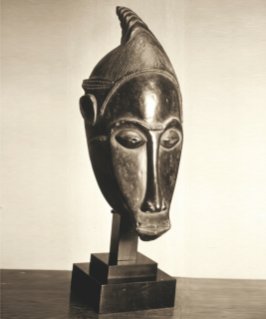Kichizo Inagaki – the mysterious Japanese cabinetmaker
Paris, 10 December 2012

Kichizo Inagaki was a Japanese cabinetmaker who rubbed shoulders with famous artists and collectors of his time, yet he remained unknown to his descendants. He was renowned for his sophisticated stands for African and Oceanian art and was very popular during the 20th Century in Paris.
Kichizo Inagaki was born in 1876, in the village of Murakami (Niigata prefecture, Honshu island, Japan). His father was an artisan and carpenter at the Royal Palace, known for his sculptures and fluency with lacquer art as well as ikebana. Kichizo went to study in Tokyo but after the death of his father he returned to his village. Soon he proved artistic abilities and mastery in traditional arts. He participated in numerous contests: in 1894 he took the second place at a sculpture contest and in 1899 he obtained third prize at the National Contest for lacquer masters.
Kichizo was more and more tempted to return to Tokyo in order to finish his studies. Become the head of the family at the death of his father, his mother reluctantly let him go. In Tokyo he attended modelling and sculpture courses. Hard working and conscious, he graduated in 1904. He moved to Hong-Kong and later, in 1906, to Paris. In those times, Paris attracted numerous Japanese artists who wished to explore Occidental techniques. At the beginning, barely speaking French, he had to sell sculptures in order to survive. In little time he was noticed by antique dealers who entrusted him the making of pedestals for Primitive and Antique artworks. While he was employed by Joseph Brummer, he met Rodin, who was looking for someone capable of restoring pieces from his collection and Kichizo seemed to him ideal for that job. In no time the whole Paris including Paul Guillaume, Louis Carré, Béla Hei, started to use the services of Kichizo Inagaki. Contrary to others, the Japane se created stands which aimed not to degrade a sculpture but able to merge with it. He was as well the one who gave wood a specific finish, making the veining visible, which in most cases was painted white but could as well be red, green or silver.
Nevertheless, pedestals’ production was not his only activity, according to Tribal Art. In fact, Kichizo Inagaki, since 1918 created furniture for Eileen Gray. Unfortunately now it is hard to determine which ones should be attributed to the Japanese. Certain number of objects created by Kichizo were preserved by his family, including a palm wood and wicker screen, a desk he made for the anniversary of his wife or some small boxes. Notably attributed to him is the parfume Nuit de Chine‘s case, distributed by fashion designer Paul Poiret. We discover as well that Kichizo Inagaki was not only an artisan at the antique dealers’ service, but well and truly an artist of multiple talents. During his whole life he never received the public’s appreciation because of his discretion and peoples’ mentality in that period. Rodin tried in vain to organise him an exhibition at the Palais de Tokyo, but gladly now, step by step, we rediscov er the work of Kichizo Inagaki.